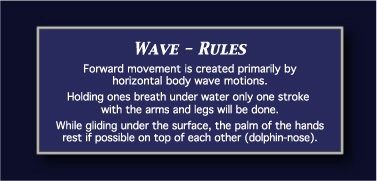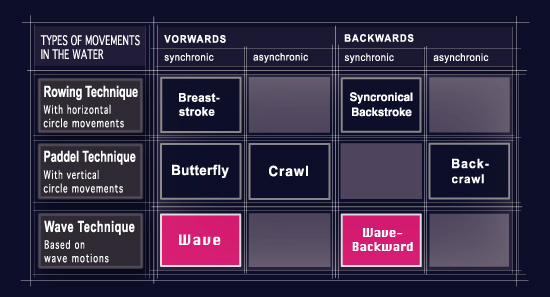SWIMMING WITH UNDULATIONS Page 1 and 2 out of the hompage
|
 |
The Wave technique is the way to swim This Website defines the Wave techique
|
|
Complete classification of swimming techniques |
The Wave technique describes a way to swim based on undulations. This may result in a forward or a backward movement. Both ways to swim have in common to make optimum use of the potential of undulations (Wave motions). Depending o the intention (freestyle or racing) the swimmer submerges about knee deep under the waters surface. Swimming with only wave motions does not really work out. The Wave technique therefore makes additional use of horizontal circle movements, like the rowing techniques (see graphic above). In order to support wave motions, the swimming techniques Wave integrates movements from swimming Breaststroke and Wave-Backward such from Synchronical-Backstroke. Wave motions may be implemented by smooth or dynamic impulses. They make possible either to swim long distances economically or to swim short distances effective. The Wave technique stands for a harmonic and integral way of moving in the water. Swimming wave develops a sense for water as well as for the body coordination and most of all; swimming "Wave" is very attractive. |
|
 |
Guidelines to the Wave technique |
Regarding the difference between Wave and Butterfly |
Wave and Butterfly have things in common. Both swimming techniques support undulations (Full body motions). The basic difference is that Wave technique’s first priority is to support wave motions in order to move forward. Butterfly on the other hand can be classified as a paddle technique. It is the synchronic application of Crawl. In technical terms Butterfly gives priority to the characteristic hand movements above water "like a butterfly" instead of a consequent following the potential of undulations. (See also history of swimming.) In contrast to Butterfly Wave focuses on harmonic flow of full body motions and therefore makes use of the full potential of undulations under water. It becomes possible to swim with a wave technique economically and over long distances. |
The Wave technique consists of three wave motions |
In order to apply the principle of undulations effectively, it is essential to perform the technique consequeltly under the water surface. So that the effort to dive is worth it at least two full wave motions with stretched out arms are necessary. Schwimming Wave, in the aplication Wave (Racing) and Wave (Freestiyle), and also Wave-Backwarts, are consequent undulation techniques, because also the diving sequence shows characteristics of a wave motions and results in the continuous course of the three undulations, one after each other. Two times short and one long step. |
The Flip turn |
Swimming under the water surface opens new possibilities to turn at the pools end. Swimming the Wave technique the Flip-turn applies, in the sense of "flip"ping over first and "turn"ing afterwards. After the last diving sequence the body is flipping over 180 degree. The remaining distance to the pool´s end is completed with wave motions backwards. The body than contracts and the legs move downwards. Meanwhile the possibility to breath opens. Starting with a strong push off with the legs, a complete wave sequence follows under the surface. That means two wave motions and the use of the arms. The turning technique backward follows the same rules, but up side down. The turning is carried out before arriving at the pools end. With the wave technique there is no more need to regulate the lengs of the underwater sequence. Performing only one Wave cycles klus is making sense now. |
The swimming technique Synchronical backstroke |
Synchronical-Backstroke is not only important as the entering form into the Wave technique backwards, but also as an independent art of swimming. Synchronical-Backstroke is based on horizontal circle movements and belongs to the rowing techniques. It characterises itself as an independent swimming technique, but not by swimming on the waters surface. Synchronical-Backstroke is initiate with the palm of the hands above each other, the same way as Wave backward. In front of the body the arms dive under the surface, in addition the upper body presses downwards until it becomes possible to overlook the swimming direction. Then the are movements are performed. At the same time the upper body bends toward the surface. From it results in an additional (curtailed) wave motion. Only by integrating this specific diving sequence Synchronical-Backstroke can be considered as independent swimming technique. In any sport there is a high priority to keep the own action under control. As such we should only speak of an independent swimming technique when it becomes possible to overlook the swimming direction. Therefore Krawl backwards could be characterised as a "blind technique". |
 |
German swimming book with many illustrations: |
SWIMMING WITH UNDULATIONS Schwimmen mit Wellenbewegunge, Ralph Ritzmann |
Update: Aug. 2016 / RR |

